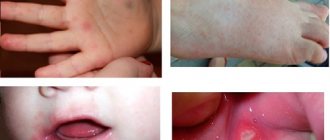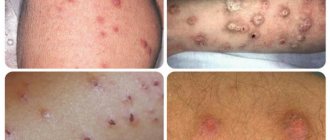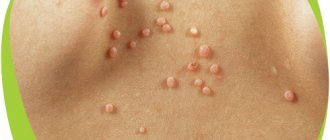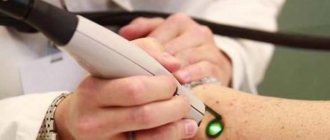The rectum worries children mainly due to pinworms and constipation. If bowel movements are painful, it can lead to constipation, as well as an anal fissure, a painful injury to the lining of the rectum, which in turn often makes constipation worse.
For many children, itching in the rectum is caused by pinworms. The itching in such cases intensifies at night; it bothers the child no less than pain associated with constipation or anal fissure. Scratching further traumatizes the skin and increases the likelihood of infection.
A streptococcal infection can also cause inflammation of the skin around the anus. Serious causes of rectal itching in children, such as hemorrhoids, are rare. It is more common in adults, but in children it can indicate a serious illness.
Any injury in a child in the anus for no apparent reason should alert parents and suspect sexual abuse of the child, especially if he refuses to explain its origin. In such cases, the child may need the help of a child psychologist.
THE DOCTOR'S CONSULTATION
Contact your doctor if your child:
- itching or bleeding from the rectum
- severe constipation
- haemorrhoids
- itching that gets worse at night
- painful red rash in the anus
- trauma to the anus
ATTENTION!
An anal fissure cannot be cured without the use of products that help soften stool. As a result of treatment, the child ceases to be afraid of pain during bowel movements.
| ASK YOURSELF A QUESTION | POSSIBLE REASON | WHAT TO DO |
| Is your child irritated and scratching his anus? Does itching get worse at night? In feces you can sometimes see small, mobile white worms, less than a centimeter long? | Pinworms | Contact a pediatrician who will examine the child and prescribe the necessary tests. All family members should be treated (see “Treatment of pinworms” at the end of this article). |
| Does the child experience pain during bowel movements and for several minutes after it? Is there fresh blood on toilet paper or in stool? | Anal fissure | Bring your child to see a pediatrician , who will examine the child and confirm the diagnosis. As a rule, an anal fissure appears if the stool is too dense. Treatment includes agents that help soften stool. As a result, the child ceases to be afraid of pain during bowel movements, which aggravates stool retention |
| A child has a painful red rash in the anus | Inflammation of the skin around the anus caused by streptococcal infection (perianal dermatitis) | Make an appointment with a pediatrician who will examine the child and, if necessary, prescribe treatment (possibly prescribing antibiotics). After defecation, rinse the anus with clean water and apply zinc ointment or a doctor-prescribed ointment. |
| Is your child bleeding from the rectum or in pain? The general condition is not impaired, is it active? | Intestinal polyps; Meckel's diverticulum; Saccular process of the ileum | Contact a pediatrician who will examine the child and, if necessary, refer to another specialist |
| Does the rectum protrude from the anus after defecation? Do you strain a lot when defecating? Does your child have a chronic, serious illness, such as cystic fibrosis? | Rectal prolapse | If your child is not in pain, gently try to push the bowel back into place with a sterile gloved finger or by wrapping it in toilet paper. Then contact your pediatrician. If your attempt causes pain or there is bleeding, contact your pediatrician . |
| Does your child have a strange gait or pain in the rectal area? Is he refusing to go potty? | Foreign body in the rectum (the child, out of curiosity, can insert it himself) | Bring your child to see a pediatrician , who will examine the child and identify a foreign body. If it is large, with sharp edges, the pediatrician will refer the child to another specialist |
| Does your child have pain, swelling, or redness in the anus? | Perianal abscess/fistula; Crohn's disease | Consult a pediatrician who will examine the child and decide what treatment is needed |
FOR INFORMATION
Treatment of pinworms
Pinworms can appear in a person of any age, level of education and wealth. They are especially common in children and are easily transmitted from child to child in kindergartens and schools. Pinworms are very annoying, but cannot cause serious harm to health, although they sometimes transfer bacteria from the rectum to the girl’s genital tract, causing vulvovaginitis. Pinworm eggs, which can be found under nails, on clothes and linen, in house dust, enter the mouth, then the stomach. There they open, and the larvae move into the small intestine, where they mature into small, mobile white worms less than a centimeter long. At night, females lay eggs on the skin in the anus. This causes itching, the child scratches the skin, the eggs get under his nails - this is how the infection cycle repeats.
When a child has itching, he is irritable and has difficulty sleeping. To diagnose, a doctor may apply adhesive tape to the anus and look for worm eggs on it.
A short course of treatment is required to cure pinworms. Because re-infection is not uncommon, treatment sometimes needs to be repeated. To disinfect clothes and linen, washing, boiling and ironing are necessary.
Description of the disease
Anal fissure develops less frequently in children compared to adult patients.
This is due to a small number of provoking factors and rapid restoration of the mucous membrane with proper treatment. The disease affects boys and girls equally often. Anal fissure is rarely encountered by children under the age of 3-5 years, whose stool is extremely rarely thick. An exception may be cases of congenital malformations of the rectum.
Depending on the nature of development, an anal fissure can be:
- acute;
- chronic.
The latter option most often occurs in adolescents in the absence of proper treatment for the disease at the earliest stages of its development.
In such cases, sometimes it is even necessary to surgically remove the affected tissue, and only then carry out conservative therapy. Depending on the location, anal fissures are divided into 3 types:
- rear;
- front;
- lateral.
The pathological process can occur with or without spasm of the anal sphincter. Prolonged tonic contraction of the annular muscles of the anus aggravates the course of the disease. Against the background of spasm, the child has bowel movements less often. This leads to hardening of the stool, which subsequently further injures the rectal mucosa. The child has a fear of going to the toilet. This closes a vicious circle, causing a deterioration in the patient’s well-being.
Allergy
Allergic reactions occur in children of all ages, and many of them can cause redness around the anus. Unpleasant symptoms can be caused by:
- Contact allergy, which occurs after using diapers, creams, wet wipes, detergents, etc. that are not suitable for the baby. In this case, redness is limited to the area of action of the allergen. White pimples may form on the affected area, the skin becomes painful, swollen, and may itch. To get rid of the problem, you need to prevent further contact with the allergen and use antihistamines in accordance with your doctor’s recommendations.
- Allergies to formula, mother's milk, other foods, medications and other factors. In this case, the child experiences systemic manifestations of individual intolerance, but the delicate skin of the anus and perineum may react to them first. In addition to redness, parents can also pay attention to various rashes, flaky areas and restlessness of the child. Manifestations of allergies are most often localized on the cheeks and forearms.
The attending physician can accurately diagnose allergies and select the optimal methods for treating them. If you suspect such a condition, you must first prevent the child from coming into contact with a possible allergen and organize a hypoallergenic diet for him.
Symptoms of anal fissure in children
The clinical picture of the disease depends on the stage of development, the individual characteristics of the child and the size of the mucosal defect. Classic symptoms of anal fissure:
- Pain in the anal area during bowel movements. This is one of the most common signs of the disease, which is caused by mechanical damage to the inner surface of the intestine. Between bowel movements, the baby can behave absolutely normally and not show any complaints.
- Blood in the stool. This is the most common reason for parents to turn to a pediatric proctologist, who notice streaks of scarlet blood during the next diaper change or while cleaning the potty. Its appearance is due to the presence of a defect in the mucosa and injury to small vessels.
- Abnormal bowel movements such as constipation. Due to pain in the anorectal area, the child tries to suppress the defecation reflex. There is a fear of bowel movements.
- Anxiety, sleep disturbance, moodiness. All these symptoms are caused by the child’s irritation, which develops against the background of pain in the anus and bowel dysfunction.
If the above symptoms occur, you should seek help from a pediatrician, proctologist or pediatric surgeon. This will allow you to identify the problem in the early stages of its development and begin adequate treatment without delay.
Overheat
Many parents are afraid that their young children will catch a cold and dress them warmer than is actually necessary. As a result, rashes called prickly heat may appear on the baby’s delicate skin. Sometimes this problem is localized in the buttocks area. Its main manifestations:
- The skin around the anus becomes red.
- Many small pimples of a reddish or pinkish color appear on the butt; they are localized in the folds and places of contact with the diaper or other items of clothing. If they become damaged, the skin begins to peel off.
- As the problem progresses, the elements of the rash become red and look like nodules.
- The rash causes noticeable discomfort, itches, the child may be capricious, have difficulty sleeping and eating. Children try to scratch the itchy areas.
- In the absence of timely and adequate correction, severe diaper rash may develop, and there is a risk of bacterial or fungal infection.
Causes of anal fissure
The pathogenetic basis for the development of anal fissure in children is a violation of the integrity of the anal mucosa. The cause of such a defect may be:
- Tear of tissue due to the passage of too thick stool.
- Incorrect placement of cleansing enemas or gas exhaust tubes when the mucous membrane is injured by hard elements of medical products.
- Incorrectly performed surgical interventions in the anorectal area.
It is important to understand that a violation of the integrity of the mucous membrane in the described situations does not always occur. The risk of developing the problem is increased by provoking factors:
- Genetic predisposition or the presence of congenital malformations of the anorectal region or the entire gastrointestinal tract (GIT).
- Chronic intestinal infections accompanied by diarrhea. In such cases, the mucous membrane becomes thinner and becomes more vulnerable to the mechanical impact of thick feces.
The situation is further aggravated by the presence of a local inflammatory process.
- Proctitis and other diseases of the rectum, which directly reduce tissue resistance.
- Metabolic disorders. Diabetes mellitus and pathology of absorption of individual food components create conditions for defecation disorders and changes in the normal architecture of tissues.
- Traumatic injuries to the anorectal area - falls, blows, scratching of the anal area against the background of helminthic infestation.
Gastrointestinal diseases
Many disorders in the digestive tract can cause redness near the anus in a child:
- Dysbacteriosis. Most often it occurs in children after taking antibiotics and consists of a disruption of the normal balance of microflora in the digestive tract. The disease can be suspected by abnormal stools (in particular, loose stools), flatulence, lack of appetite, audible rumbling in the child’s tummy, etc. The delicate skin of the anus is irritated by feces, becomes reddened, hurts and can peel off.
- Diarrhea of various origins. Regardless of the origin of loose stool, it has an aggressive effect on the skin of the anus.
- IBS. With irritable bowel syndrome, disturbances in the functioning of this organ are observed. In this case, the child is bothered by frequent diarrhea or systematic constipation (it is these factors that lead to irritation of the anus), possibly bloating and belching. There are many factors that can cause this disease, including stress and all kinds of psychological disorders.
If there are disturbances in the functioning of the digestive tract, it is better not to engage in self-diagnosis and self-medication. An experienced doctor will conduct the necessary research, make an accurate diagnosis and select the optimal treatment.
Expert opinion
Anorectal fissure in a child is a relatively favorable condition compared to adults. If you seek specialized help in a timely manner, the problem can be eliminated conservatively in a short time. Due to the good ability to restore the mucous membrane in children, therapy can take only 4-5 days. The main thing is not to ignore the first signs of the disease. Otherwise, an acute crack becomes chronic, becomes a cause of daily discomfort for the patient, and requires surgical intervention.
Content
- The causative agent of parasitic infection is pinworm
- Causes of pinworm infection
- What complications does the disease cause?
- Symptoms of the disease Acute period
- Chronic stage
Enterobiasis is an infection of the body with helminths - pinworms. Young children are at risk, but children of other ages can also be infected.
Diagnosis of anal fissure
Anal fissure is diagnosed by a pediatric proctologist or surgeon.
Even when parents first contact a doctor, a specialist may suspect the presence of this disease. The doctor pays attention to the child’s characteristic complaints, the influence of provoking factors, and the history of the development of the pathological process. A digital rectal examination is required to make a definitive diagnosis. However, in order not to cause psycho-emotional discomfort in the presence of severe pain, the doctor may first limit himself to a simple examination of the anal area. Sometimes the defect can be identified immediately.
If a rectal examination is not performed immediately, it will be postponed to the next visit. The fact is that anal fissures are often a consequence of other proctological diseases, which may not be diagnosed without a full examination. This means that the pathology of the rectum will steadily progress.
To comprehensively assess the patient’s condition, the following tests are performed:
- General blood and urine analysis. Allows you to identify concomitant diseases, primarily anemia, inflammation.
- Coprogram is a microscopic analysis of feces, which is especially important if dysfunction of other parts of the gastrointestinal tract is suspected.
- Blood chemistry. Detects metabolic changes in the body.
- Ultrasound of the abdominal organs. Detects abnormalities in the development of internal organs.
If a concomitant pathology is identified, its treatment is carried out in parallel, which helps to avoid recurrence of the anal fissure.
Treatment of anal fissure
Anal fissure in children is a disease that in the early stages of its development responds well to conservative treatment. Surgery may be indicated only if drug therapy is ineffective or the process is long-term and chronic, when a ridge of dense scar tissue forms around the crack, interfering with healing.
Conservative treatment
A key aspect of effective treatment of anal fissure in children at an early stage of the disease is the correction of diet and water balance.
This allows you to soften the stool and prevent re-traumatization of the mucous membrane. It is recommended to temporarily exclude fatty and fried foods from the diet and reduce the amount of meat consumed. It is worth increasing the amount of fruits and vegetables that are rich in fiber. Coarse fiber attracts liquid, increases the volume of stool and thereby helps normalize stool. In addition to diet correction, the proctologist prescribes the following groups of medications:
- Mild laxatives (if constipated).
- Healing ointments and creams, suppositories.
- Anti-inflammatory suppositories.
To cleanse the intestines and eliminate the local inflammatory process, it is recommended that the child take baths with chamomile decoction for 2-5 days. The water temperature is about 37°C. If a child has anemia due to minor bleeding, the doctor prescribes iron supplements, vitamin B 12, and folic acid.
Surgery
Surgical excision of anal fissure in children is performed when conservative treatment methods are ineffective.
It is indicated for the chronic form of the disease and is practiced mainly in adolescence, when the process has turned from acute to chronic. The essence of the operation is the excision of pathological scar tissue and the crack itself with further suturing of the defect. After this, the patient receives standard conservative therapy aimed at stabilizing the stool and healing the postoperative wound.
Pinworms - Baby food
“Sadikov's disease” - enterobiasis?
When a child’s body is affected by worms, the mother must take care of the baby’s specific nutrition. Eating the right foods can speed up the healing process. It is worth including in the diet:
- Spicy dishes. Pepper and spicy dressings worsen the habitat for pinworms.
- Sour vegetables and fruits. In an acidic sphere, parasites die faster.
- Horseradish with mustard. Not all kids will like such a specific product. But it undermines active reproduction and temporarily paralyzes the worms.
- Walnuts, flax seeds, pumpkin seeds. Such products help destroy parasites in the intestines.
- Olive and vegetable oil. Relieves irritation of the intestinal walls.
- Dairy products. With their use, medications are better absorbed and the intestinal microflora is not disturbed.
During the period of illness, it is recommended to exclude sweets, fatty foods, and foods with a chemical composition - the consumption of harmful foods creates all the conditions for the further proliferation of pinworms in the child’s body.
Questions
- Which doctor treats anal fissure in children?
A pediatric proctologist or surgeon is involved in identifying and treating anal fissure. - Is it possible to cure anal fissure with folk remedies?
Conservative treatment of anal fissure in children is aimed at stabilizing stool and rapid healing of damaged tissue. In some cases, this effect was achieved using traditional medicine - chamomile baths, sea buckthorn suppositories and other local remedies in combination with diet. However, in any case, you must first consult with a specialist. Anal fissures are often a consequence of other proctological diseases, which can progress without adequate treatment. - Does my child need surgery for anal fissure?
In 90% of cases, if the patient seeks help in a timely manner, surgical intervention is not required. Timely initiation of conservative therapy promotes complete healing of the mucosal defect without subsequent relapses. The exception is advanced cases when dense scar tissue forms along the edges of the crack, which interferes with healing. As part of the surgical intervention, it is excised and the defect is sutured, after which standard medications are prescribed to speed up healing. - How to independently identify an anal fissure in a child?
Pain during bowel movements and red blood in the stool are sure signs of a problem. You can also examine your child's anal area yourself. In 50-60% of cases, the mucosal defect is visible without the use of additional instruments. However, such a self-diagnosis complex does not replace consultation with a specialist. Only a comprehensive examination and personalized treatment can radically solve the problem of anal fissure in childhood.
Treatment methods for detecting pinworms in a child
To treat enterobiasis, the doctor prescribes anthelmintic drugs. The dosage is determined according to the age and weight of the patient. It must be remembered that all these drugs are highly toxic and can cause adverse reactions. Pediatricians do not recommend choosing medications without consulting a specialist.
If a child is diagnosed with pinworms, then all family members need to undergo treatment. If there is a pet living in the house, it is also necessary to purchase anti-worm medication for it.
During treatment, it is also necessary to take sorbents, since anthelmintic drugs do not remove parasites from the body.
An effective regimen for taking medications and necessary procedures is prescribed by the doctor.
A number of hygiene procedures for the home are necessary:
- after the end of treatment, change the linen by ironing it with a hot iron;
- boil or wash the toys in hot water with added salt;
- Regularly carry out wet cleaning at home.










